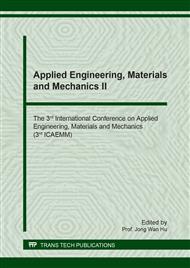[1]
P. Nie, L. Shen, H. Luo, B. Ding, G. Xu, J. Wang and X. Zhang, Prussian blue analogues: a new class of anode materials for lithium ion batteries, J. Mater. Chem. A. 2 (2014) 5852-5857.
DOI: 10.1039/c4ta00062e
Google Scholar
[2]
A. A. Karyakin, Prussian Blue and Its Analogues: Electrochemistry and Analytical Applications, Electroanalysis. 13 (2001) 813-819.
DOI: 10.1002/1521-4109(200106)13:10<813::aid-elan813>3.0.co;2-z
Google Scholar
[3]
C. Xu, B. Li, H. Du and F. Kang, Energetic Zinc Ion Chemistry: The Rechargeable Zinc Ion Battery, Angew. Chem. Int. Ed. 51 (2012) 933-935.
DOI: 10.1002/anie.201106307
Google Scholar
[4]
B. Lee, C. S. Yoon, H. R. Lee, K. Y. Chung, B. W. Cho and S. H. Oh, Electrochemically-induced reversible transition from the tunneled to layered polymorphs of manganese dioxide, Sci. Rep. 4 (2014) 6066-6073.
DOI: 10.1038/srep06066
Google Scholar
[5]
L. Chen, H. Shao, X. Zhou, G. Liu, J. Jiang and Z. Liu, Water-mediated cation intercalation of open-framework indium hexacyanoferrate with high voltage and fast kinetics, Nat. Commun. 7 (2016) 11982-11991.
DOI: 10.1038/ncomms11982
Google Scholar
[6]
C. J. Du, F. X. Bu, D. M. Jiang, Q. H. Zhang and J. S. Jiang, Prussian blue analogue K2Zn3[Fe(CN)6]2 quasi square microplates: large-scale synthesis and their thermal conversion into a magnetic nanoporous ZnFe2−xO4–ZnO composite, CrystEngComm. 15 (2013).
DOI: 10.1039/c3ce41753k
Google Scholar
[7]
S. Wu, X. Shen, H. Zhou, G. Zhu, R. Wang, Z. Ji, K. Chen and C. Chen, Morphological synthesis of Prussian blue analogue Zn3[Fe(CN)6]2·xH2O micro-/nanocrystals and their excellent adsorption performance toward methylene blue, J. Colloid Interf. Sci. 464 (2016).
DOI: 10.1016/j.jcis.2015.11.036
Google Scholar
[8]
M. Pasta, R. Y. Wang, R. Ruffo, R. Qiao, H. W. Lee, B. Shyam, M. Guo, Y. Wang, L. A. Wray, W. Yang, M. F. Toneye and Y. Cui, Manganese–cobalt hexacyanoferrate cathodes for sodium-ion batteries, J. Mater. Chem. A. 4 (2016) 4211-4223.
DOI: 10.1039/c5ta10571d
Google Scholar
[9]
X. Sun, V. Duffort and L. F. Nazar, Prussian Blue Mg-Li Hybrid Batteries, Adv. Sci. 3 (2016) 1600044-1600050.
DOI: 10.1002/advs.201600044
Google Scholar
[10]
R. Y. Wang, B. Shyam, K. H. Stone, J. N. Weker, M. Pasta, H. W. Lee, M. F. Toney and Y. Cui, Reversible Multivalent (Monovalent, Divalent, Trivalent) Ion Insertion in Open Framework Materials, Adv. Energy Mater. 5 (2015) 1401869-1401878.
DOI: 10.1002/aenm.201401869
Google Scholar
[11]
L. Zhang, L. Chen, X. Zhou and Z. Liu, Towards High-Voltage Aqueous Metal-Ion Batteries Beyond 1.5 V: The Zinc/Zinc Hexacyanoferrate System, Adv. Energy Mater. 5 (2015) 1400930-1400934.
DOI: 10.1002/aenm.201400930
Google Scholar
[12]
Z. Hou, X. Zhang, X. Li, Y. Zhu, J. Liang and Y Qian, Surfactant widens the electrochemical window of an aqueous electrolyte for better rechargeable aqueous sodium/zinc battery, J. Mater. Chem. A. 5 (2017) 730-738.
DOI: 10.1039/c6ta08736a
Google Scholar
[13]
H. W. Lee, R. Y. Wang, M. Pasta, S. W. Lee, N. Liu and Y. Cui, Manganese hexacyanomanganate open framework as a high-capacity positive electrode material for sodium-ion batteries, Nat. Commun. 5 (2014) 5280-5285.
DOI: 10.1038/ncomms6280
Google Scholar
[14]
C. D. Wessells, S. V. Peddada, R. A. Huggins and Y. Cui, Nickel Hexacyanoferrate Nanoparticle Electrodes For Aqueous Sodium and Potassium Ion Batteries Nano Lett. 11 (2011) 5421-5425.
DOI: 10.1021/nl203193q
Google Scholar
[15]
C. H. Lee and S. K. Jeong, A Novel Superconcentrated Aqueous Electrolyte to Improve the Electrochemical Performance of Calcium-ion Batteries, Chem. Lett. 45 (2016) 1447-1449.
DOI: 10.1246/cl.160769
Google Scholar
[16]
A. Hazza, D. Pletcher and R. Wills, A novel flow battery: A lead acid battery based on an electrolyte with soluble lead(II) Part I. Preliminary studies, Phys. Chem. Chem. Phys. 6 (2004) 1773-1778.
DOI: 10.1039/b401115e
Google Scholar
[17]
D. Kim, C. Lee and S. Jeong, A concentrated electrolyte for zinc hexacyanoferrate electrodes in aqueous rechargeable zinc-ion batteries, Mater. Sci. Eng. 284 (2017) 012001-012006.
DOI: 10.1088/1757-899x/284/1/012001
Google Scholar
[18]
R. Y. Wang, C. D. Wessells, R. A. Huggins and Y. Cui, Highly Reversible Open Framework Nanoscale Electrodes for Divalent Ion Batteries, Nano Lett. 13 (2013) 5748-5752.
DOI: 10.1021/nl403669a
Google Scholar
[19]
D. E. Irish and T. Jarv, Vibrational Spectral Studies of Solutions at Elevated Temperatures and Pressures. IV. Raman Spectra of Aqueous Zinc Nitrate Solutions, Appl. Spectrosc. 37 (1983) 50-55.
DOI: 10.1366/0003702834634109
Google Scholar
[20]
Y. K. Sze and D. E. Irish, Vibrational Spectral Studies of Ion-Ion and Ion-Solvent Interactions. I. Zinc Nitrate in Water , J. Solution Chem. 7 (1978) 395-415.
DOI: 10.1007/bf00646111
Google Scholar
[21]
Y. Ikushima, N Saito and M Arai, Raman Spectral Studies of Aqueous Zinc Nitrate Solution at High Temperatures and at a High Pressure of 30 Mpa, J. Phys. Chem. B. 102, (1998) 3029-3035.
DOI: 10.1021/jp980458b
Google Scholar


